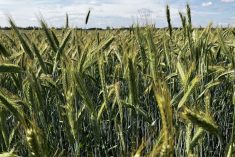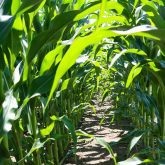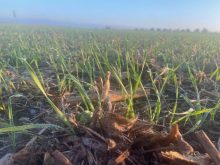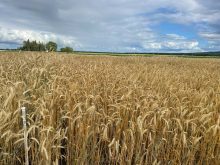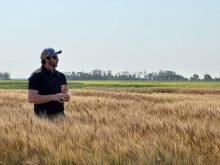Experts expect a lot of winter cereals to be planted this fall despite a wide range of weather conditions across the Prairies.
Why it matters: Moisture and disease conditions vary but recommendations are consistent.
Manitoba, generally the wettest of the three Prairie provinces, lived up to its reputation this year. Above-average precipitation blanketed the province in the first half of summer. At the end of July, some regions had received more than 170 per cent of normal rain since the start of May, according to Manitoba Agriculture weather data.
Read Also

Manitoba boosts stake in cereals centre to $23.5 million
Premier Wab Kinew said the additional project funds will help ‘Trump-proof’ the provincial economy.
Conditions dried out somewhat in August. As of Sept. 3, the province measured anywhere from 93 to 129 per cent of normal moisture in the Interlake. Parts of eastern and western Manitoba dipped as low as 76 per cent of normal.
Soil moisture in some regions crept back into the red despite significant earlier rainfall. Manitoba Agriculture reported that as of Sept. 2, areas in the east, the Red River Valley and the Interlake had dry to very dry soil conditions in the top 30 centimetres. Similar dry patches emerged in western Manitoba, including a swath from Minto north through Riding Mountain National Park.
Alberta and Saskatchewan both had mostly dry growing seasons. There were pockets of moisture in June, offset by steady heat in July. Data from Agriculture and Agri-Food Canada showed large portions of southwestern Saskatchewan and much of Alberta were at least 30 millimetres shy of normal rainfall in the last 90 days.
“Luckily for winter cereals, we don’t need a ton of moisture for winter wheat to germinate. And that’s just because we seed winter wheat pretty shallow, so it doesn’t need a lot of rain to get going,” said Carmen Prang, agronomy extension specialist with SaskWheat. “If we get even one or two timely rains, that would be ideal.”
Seeding success
Brian Beres, an agronomy research scientist with AAFC, urged good seed to soil contact when planting. Waiting for rain only helps if the land is so dry that it would be like “trying to plant into a sidewalk,” he said.
Unfortunately, that description matches conditions faced by some farmers. If a producer tries to wait out the dry spell, Beres warned, they may have to increase seeding rates.
“Provided you’re not planting in November, you’re probably going to be OK that way (waiting for rain) too; just temper expectations.”
If moisture is a worry, experts recommend seeding into a straight cut canola field for the sake of snow catch to ensure spring moisture.
Anne Kirk, a cereal specialist with Manitoba Agriculture, said flax or barley are other preceding crop options, although the potential pest and pathogen carryover of planting a cereal on a cereal must be considered.
In Manitoba, high moisture led to fusarium problems in some spring cereal fields, as well as hot spots for ergot. Alberta and Saskatchewan have been dealing with white curl mite. Manitoba and parts of Saskatchewan also had some wheat fields fall prey to leaf rust.
Kirk and Prang said paying attention to rotation and noting nearby fields of cereals can protect the winter crop. If the field of choice was previously planted with a cereal, and there is cereal stubble nearby, they recommend pre-seed burnoff.
Fungicide, insecticide and seed treatment is also recommended. Beres called that “critically important.”
“It actually gives you much improved resistance to abiotic stress and you get significantly more plants in the field by doing that.”
Watch the weeds
Winter cereals should have a clean slate in which to establish, rather than competing against weeds. Kirk said fall weed control may be particularly important in Manitoba because many producers missed the ideal spring weed control window due to excess moisture.
“In some cases, pesticides went on at a later timing than they would have liked, and weed control wasn’t the greatest,” she said.
Research from AAFC recommends herbicide application after the three-leaf stage of a winter cereal crop, which is usually around the second week of October.
“That would be a perfect time to go in and put an application of a full rate of 2,4-D down,” Beres said. “Not any kind of tank mix, just 2,4-D. If you do that, that’s probably all the herbicide you’re going to need in your winter wheat crop.”
Feed the crop
Opinions vary on whether fertilizer for a winter cereal should all be applied in fall or split between fall and spring. If wet spring conditions are likely or spring labour issues are a factor, experts say a full fall application may be best, but that decision will vary for each farm.
If fall application is preferred, Beres and Prang suggest a slow release option such as polymer-coated urea.
For an early look at this year’s winter wheat cereal variety trail data, click here. Data on variety yield performance across Manitoba sites, as well as variety traits such as disease resistance, is provided from the Manitoba Crop Variety Evaluation Team to help producers choose the winter cereal variety that best fits their farm.





